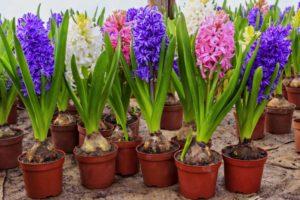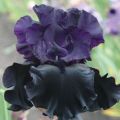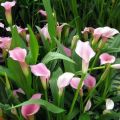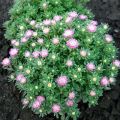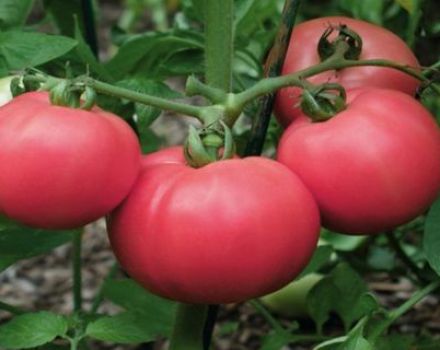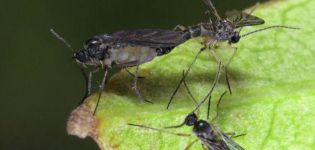Description of 20 varieties and types of perennial penstemon, planting and care in the open field
Perennial penstemon has a rather bright appearance and a pleasant aroma; it is able to decorate any area where it grows. This flower is simply the record holder for the number of varieties and colors, among which every gardener will be able to choose an option to his liking.
Description and features
Penstemon is a perennial shrub and semi-shrub plant from the Norichnikov family. The homeland of the flower is North and Central America. The bush has from 1 to 4 erect stems, the height of which varies from 20 cm to 120 cm. They are bright green or brownish brown. The foliage is lanceolate with solid edges and a shiny surface.
Flowering begins in May-June, in some representatives it lasts until October, such as the Carillo purple variety. Flowers are tubular or bell-shaped. They come in one color or several colors at once. Life expectancy depends on the specific variety, some varieties live for 2 years, others can live for 7 years. Well pollinated by bees.
Popular varieties and types
These plants have about 270 species. In our area, these flowers are not yet very popular, so only a few of them are on sale.
Foxglove
The variety has high frost resistance. It grows up to 120 cm. It has creamy or slightly pink inflorescences, which are always white inside. Blooms in June or early July.

Dark Towers
This variety was developed relatively recently. It is distinguished by an abundance of flowering and increased frost resistance. The foliage of the Dark towers variety has a rich burgundy color, which goes well with pale pink flowers.
Carilo Red
Has green foliage and stems. It grows no more than 60 cm in height. It has bright scarlet flowers. The flowering period is from June to October.
Harweg
This is one of the most popular varieties. The plant grows up to 60 cm. The inflorescences are large, can be of different colors, but usually white in the middle. Blooms in early June and blooms until the first frost.

Davidson
This species is creeping, it is one of the smallest, it grows only 20 cm. It blooms with blue or lilac inflorescences. The foliage is small, oval in shape.
Mystic
Penstemon Mystica has purple-green foliage. It blooms with pale pink racemose inflorescences.Has a pleasant aroma. The plant grows up to 70 cm.
Bell-shaped
The variety got its name from its flowers. They have the shape of bells of pink and lilac color. Foliage and stems are light green in color. Blooms from June to September.
Hybrid
A bushy type of penstemon, growing up to 80 cm. It blooms for about a month, but with timely pruning, it blooms again at the end of summer. Inflorescences are blue.
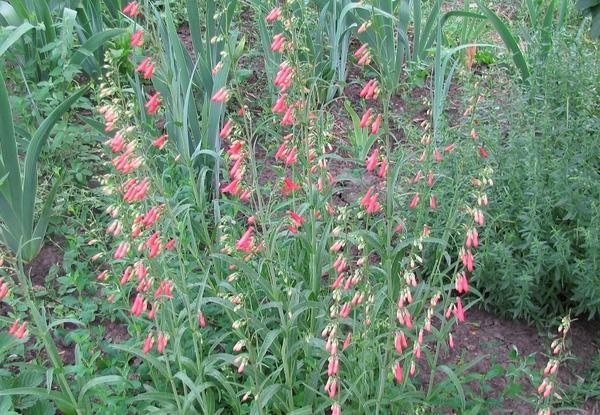
Haired
It grows up to 90 cm. The leaves and the stem are covered with small, but rather tough hairs. Hence the name of the variety. The bush blooms in early summer and continues to bloom for just over a month.
Sensation
This variety does not grow more than 45 cm. The foliage is sharp with a bright green color. The flowers are always blue-white or white-red.
Rubra
Rubra is a tall variety with tubular flowers. They can be of different colors, most often there are red, pink, purple and burgundy shades.
Pygmy
A low-growing representative, reaching only 20 cm. The foliage is lush, dark green. Inflorescences racemose with delicate lavender color. Blooms from June to August.
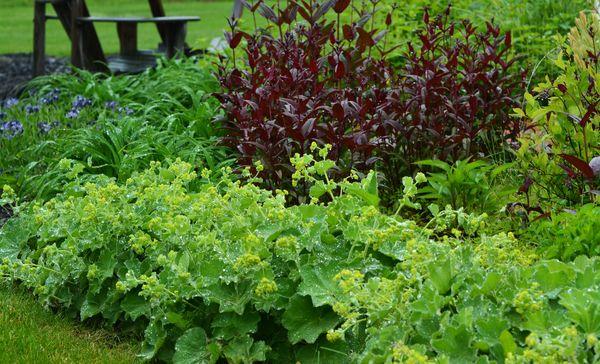
Cobo
One of the highest varieties of penstemone flower. It grows up to 120 cm. It has light green foliage with sharp ends. The flowers of the variety are large, can have different colors, always with white, namely: purple, pink, purple, red and completely white.
Red-leaved
This penstemon has large, lamellar maroon leaves. The height of the plant is about 70 cm. Flowers are bell-shaped, they are purple, pink, white and red.
Alpine
This is a ground cover, the height of which does not exceed 30 cm. It forms an elastic cushion on the soil with blue, purple or blue inflorescences. In the right soil, the flower can survive frosts down to -30 degrees.
Darkleaf
This flower blooms all summer. It has maroon foliage with narrow tips and pink-white inflorescences.
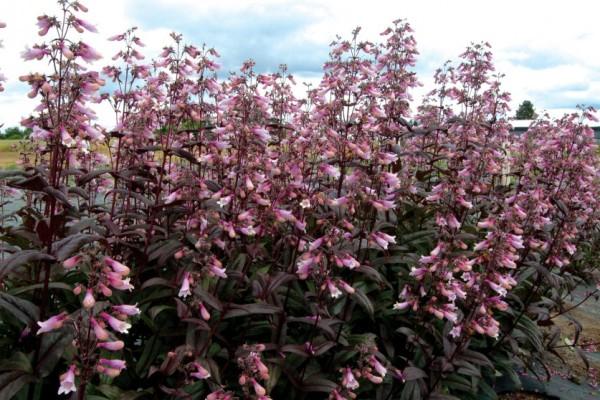
Pine-leaved
This bush has thin leaves similar to pine needles. They are densely located on the stem. Flowers are often red, less often yellow.
Hasker red
A frost-resistant variety that grows up to 90 cm high. The foliage is red with a bronze tint. The flowers are airy with a white-pink tint. Blooming time falls on June-July.
Twisted
A variety with wide leaves, sometimes with a red tint. Its flowers are collected in spreading panicles of bluish-purple color. Blooms in June-July, sometimes blooms again in September.
Growing seedlings
In order to grow penstemone, you will have to make an effort and be patient.
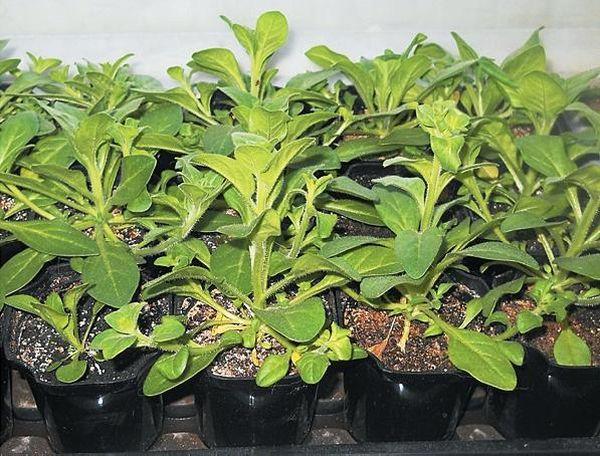
Timing
The most suitable period for sowing seeds for seedlings is the end of February - beginning of March.
Soil preparation
The soil for sowing seeds should be light, nutritious and well-drained. Sow the seed into a slightly moist soil.
How to plant
The containers are filled with soil and future seedlings are sown in them. Sprinkle on top with a thin layer of disinfected sand. To do this, it is enough to spill it with boiling water.
It is not worth deeply deepening the seeds, this will reduce their germination.
From above, the containers are covered with polyethylene or glass to create a greenhouse. Put in a warm, bright place.
Watering
It is important that the soil does not dry out, otherwise the seeds will not germinate well or not at the same time. From time to time, the seedlings are opened, aired and sprayed with a spray bottle. The germination process lasts 1 to 3 weeks, depending on the penstemona variety.
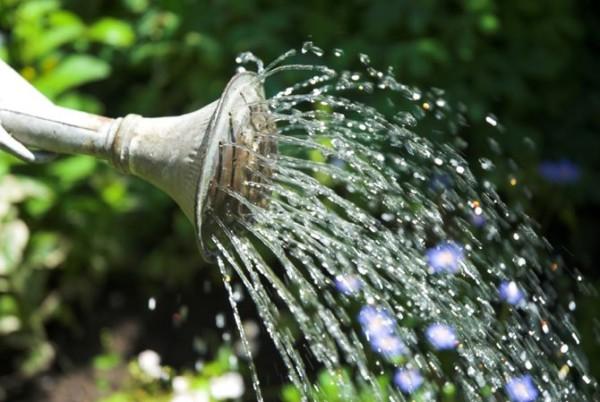
Picking
After 10-15 days, the shoots have already formed 2-3 true leaves. And this means that they need to be dived into separate containers with peat.
Transfer
Already grown plants are transplanted into open ground. This process takes place at the end of May. The site must be sunny and free of drafts.
Important! The sooner the penstemone is planted in open ground, the later it will begin to bloom.
Compost, peat or sand are added to the dug holes, and fine gravel is also used. When planting seedlings, a distance between plants of 30-35 cm should be observed.

Mulching
The soil around the flowers can be mulched to reduce the amount of watering. For this, dry peat or compost is used.
Top dressing
As a top dressing, organic fertilizers are applied under the bush. This is done 3 times per season. And before the plant begins to bloom, it is fed with complex mineral fertilizers that contain phosphorus. Such feeding has a positive effect on flowering, enhancing it and making the bush more decorative.
Bloom
The flowering period for each variety comes at different times, but most often it is June. This process continues until the end of summer, and in some varieties, even until the first frost. The beginning of flowering is influenced not only by the variety, but also by the time of planting, the soil in which the flower grows, and its care. After the plant has faded, seeds begin to form, which are used for reproduction.
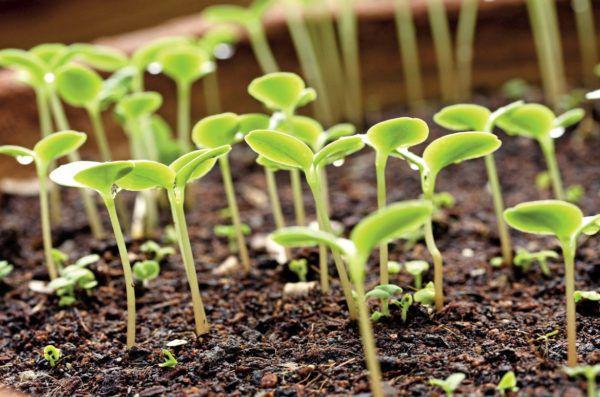
Pruning
During the development of the flower, you need to periodically prune. Withered inflorescences and foliage are cut off. They also thin out overgrown bushes. This will increase the decorative effect of the plant and extend the flowering period.
Preparing for winter
Winter frosts below -10 degrees for most of the penstemon varieties can be adversely affected. In order to preserve the plants, after the end of flowering, their stems are cut at the root and insulated with dry foliage or spruce branches.
Diseases and pests
Penstemones are resistant to diseases, but if the plant is systematically flooded or water stagnates under the bushes for a long time, fungal diseases, in particular gray rot, can develop. In order to cure the plant, the soil under the bush is loosened and watered with fungicides.

Sometimes the top of the plant dries up. In order to get rid of this problem, you need to completely cut the bush. Without doing this, you can lose the plant. When pruned, penstemon will quickly recover and start new shoots.
This flower is of no interest to insects, so they rarely attack it.
Reproduction
Penstemone can be propagated in several ways:
- cuttings;
- layering;
- dividing the bush;
- seeds.
Cuttings
This breeding method is carried out in the middle of summer. At this time, the shoots of the bush are already strong enough. In order to prepare cuttings, you need to select stems without inflorescences and cut them off. The length should be about 25 cm.

Next, the cuttings are dipped into water with root formation stimulants dissolved in it. When roots begin to appear on the cuttings, they are planted in open ground, covered with cut plastic bottles.
Layers
To propagate plants with the help of layering, you will only get undersized and creeping specimens. It is necessary to tilt the extreme shoot, fix it with a bracket and cover it with soil. After 25-30 days, roots are formed on the cut, now the shoot is cut off from the mother bush, dug out and transplanted to a permanent place in the prepared hole.
Dividing the bush
In order to get material for planting, you need to dig up a bush of an adult plant. It is carefully freed from the soil and divided into 2-3 parts. For each part, a hole is dug, fertilized and planted.
Having chosen this breeding option for penstemon, it is important to know that it is suitable only for those representatives who have reached the age of three. Otherwise, the entire bush will die.

The division of the bush is also used to rejuvenate plants. It is necessary for specimens that have reached the age of five. If such rejuvenation is not done, then the bush begins to age, the formation of new shoots stops, the bush may stop blooming and lose its decorative effect.
Collection and storage of seeds
After the penstemon has faded, the fruit ripens.It is a box that contains the smallest seeds. After collecting, the seeds are stored in a paper bag in a dry, warm place. In such conditions, the seeds retain their germination for 2 years.
Use in landscape design
Penstemons look great in any composition, since they have a wide variety of colors, come in different sizes and bloom for a long time. In mixborders, they look great with cloves, echinacea, catnip, cuffs, sage and other plants.
They are used for flower beds, rabatoks, alpine slides, for edging borders, as well as penstemons are planted in pots and decorate balconies and terraces with them.

